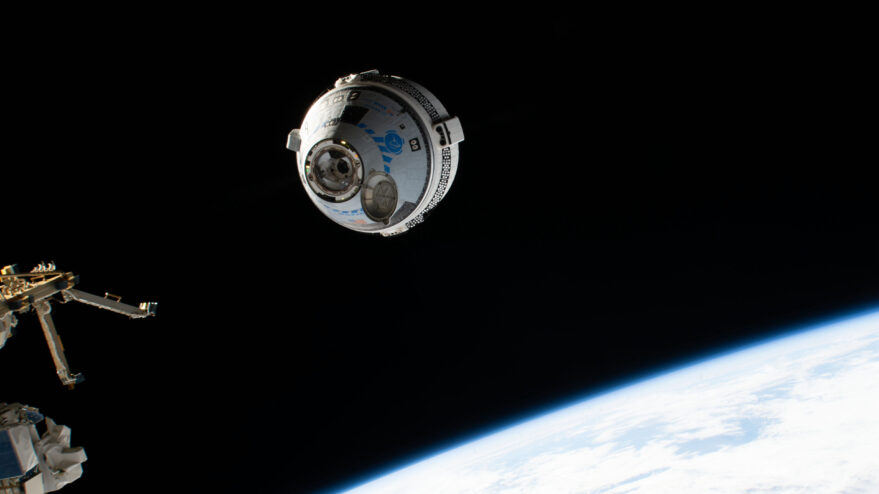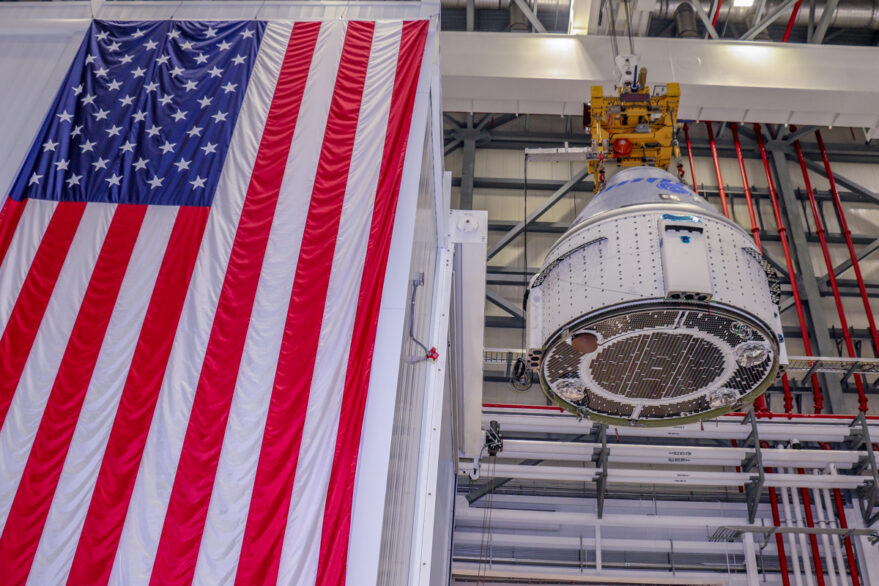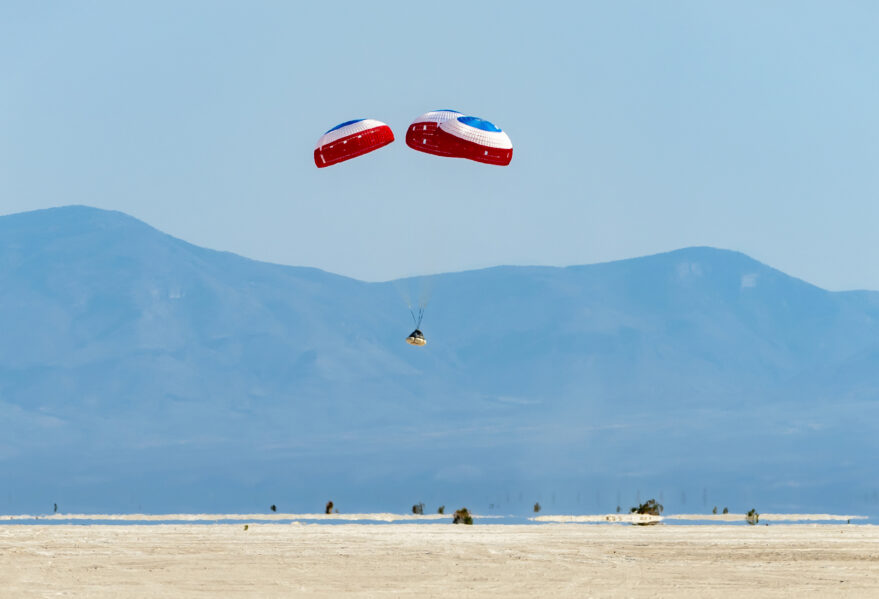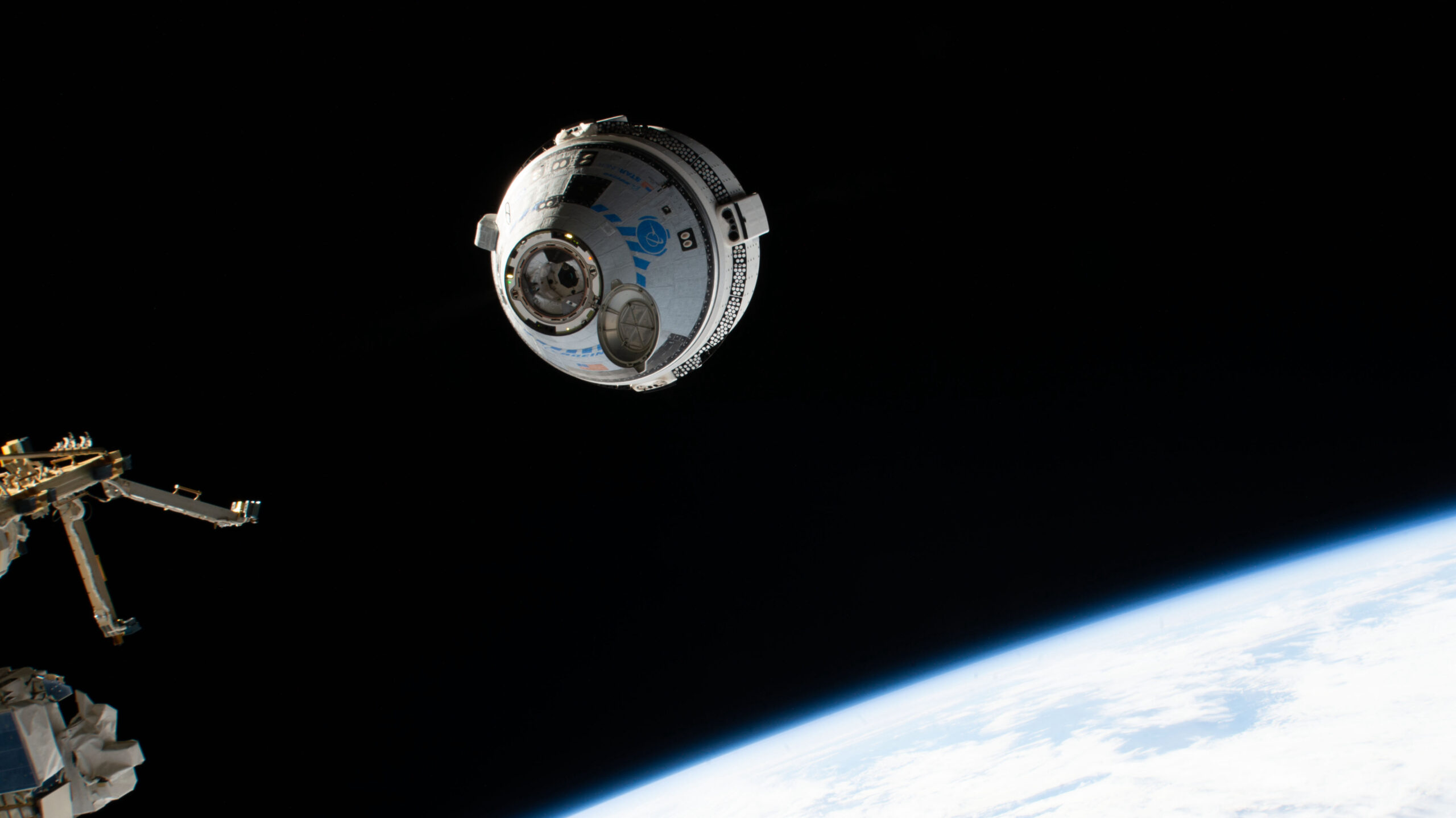Products You May Like
Laser-vision star tracker, docking system, and desert landing proven as practical space applications of the future

One day after launching May 19 from Florida’s Space Coast on a United Launch Alliance Atlas V rocket, the CST-100 Starliner spacecraft docked to the International Space Station, or ISS, signifying a historic moment for the program.
That moment was the first step toward next carrying astronauts to and from the space station, which will expand Starliner’s reach in low-Earth orbit and shape the future of commercial human spaceflight.
What followed was ISS astronauts opening the hatch of the uncrewed Starliner and then floating inside, marking the first time the spacecraft hosted people on orbit.
Starliner Mission Director LeRoy Cain had a front-row seat. The deputy program manager and director of program integration for Boeing’s Commercial Crew Program was on console at the Mission Control Center in Houston after watching the 6:54 p.m. ET launch in person a day earlier at Cape Canaveral Space Force Station.
“It was really exhilarating to watch,” said Cain, who previously worked at NASA for 28 years and directed 20 space shuttle missions. “And it was pretty neat to have our team see U.S. astronauts floating around in our vehicle.”
Boeing’s CST-100 Starliner is a next-generation spacecraft developed as part of NASA’s Commercial Crew Program, which partners with private industry to build and operate safe and reliable crew transportation systems.
“OFT-2 was a great test for us,” Cain added. “We demonstrated the capacity of the vehicle to fly to the space station and to dock. That was uplifting and fulfilling for the whole team.”
The next time Starliner flies, experienced Naval aviators and test pilots Barry “Butch” Wilmore and Sunita “Suni” Williams, will be on board as commander and pilot respectively. They will be the first of many to fly to and from low-Earth orbit destinations, including the ISS, aboard Starliner.
Boeing’s technological advances for future space applications
Starliner is part of Boeing’s Space and Launch division, which has a role in building the world’s largest rocket, small satellites, in-space habitats, and everything in between. Engineers have spent years developing innovative technologies that today, for example, set Starliner apart from other vehicles.
One of the most notable and unique innovations is Starliner’s fully autonomous universal navigation system. Called the Vision-based, Electro-Optical Sensor Tracking Assembly, it acts as the “eyes” of the spacecraft, determining the location and orientation of the vehicle relative to the stars around it. VESTA, as it’s called, was born out of a partnership between Boeing’s Laser & Electro-Optical Systems, or LEOS, and Phantom Works, which originally used the technology to acquire, track and defeat drones. Its first use in space was during the Orbital Express satellite repair mission in 2007. Although VESTA is fully autonomous, pilots have the capability to engage and maneuver the spacecraft at any time. What sets VESTA apart is that it not only can dock Starliner with a fully prepared and welcoming space station, but it can also find and lock in with a host of other, possibly less mature, destinations in space. This capability gives Starliner many options when choosing future space destinations under numerous mission scenarios.
Starliner’s cameras, sensors, and computers work together to see the area around the spacecraft and autonomously steer it to its docking port, a lot like the future envisioned for self-driving cars. First, Starliner uses its space-based GPS system to figure out where it is and calculate what it needs to do to reach the ISS or any other destination. When the cameras and sensors are close enough, they pick out the bright light of the ISS silhouette against a backdrop of stars. The computers aboard Starliner time precise thruster firings to move the spacecraft carefully along a path to rendezvous with the target, line up with the docking port and then gently make contact and complete the connection. It may sound easy, but all of it is done as both Starliner and ISS are moving above Earth at 17,500 mph. The sensors on Starliner carefully measure the speed as the two spacecraft come near each other. By accelerating slowly at precise distances, the capsule inches toward the ISS at .002 meters per second – slow enough that when contact is made, neither Starliner nor the ISS is jostled.
“VESTA is the heart of the Starliner GNC (Guidance, Navigation, and Control) system and provides commands that guide the spacecraft. During OFT-2, VESTA demonstrated Starliner’s ability to hold and control attitude while approaching the ISS keep-out-sphere before proceeding with final docking,” said Cain.
The next two innovations were demonstrated during the physical connection of Starliner and the ISS. During the last few meters of approach and through what’s called “hard dock,” it was showtime for the Boeing-developed NASA Docking System, or NDS, and the International Docking Adapter, or IDA, also made by Boeing. Essentially, there are two connections the docking systems need to make to complete a connection. First, three latches on Starliner’s extended docking ring need to snap closed as soon as Starliner’s docking hatch touches the docking adapter of the ISS. Those three latches will be the only things holding the two spacecraft together for the first several minutes to allow shock absorbers to smooth out any leftover energy from the docking process. Then the docking ring retracts to bring Starliner’s nose into place and motors drive six hooks closed to make Starliner a part of the ISS complex. At the end of the mission, the same strong hooks and latches that worked so hard to bring the spacecraft together have to release just as carefully so Starliner can depart the ISS safely.
The two were developed by Boeing under a NASA contract to meet the international space community’s desire for a universal docking system that could be used by any spacecraft to connect to another in any orbit and on any mission. Their demonstration on orbit sets the stage for deep space exploration missions and future commercial space stations such as Orbital Reef, a commercially developed owned, and operated space station that will operate as a mixed-use business park in low-Earth orbit. For Starliner, Boeing added a hinged re-entry cover to the NDS for additional protection during the capsule’s descent back to Earth. “With reusability in mind, we built the NDS for multi-mission use,” said Cain.
While in flight and when returning, Starliner also uses solar energy to help power the spacecraft. The solar cells, which are located at the bottom of the spacecraft’s service module, are built by Spectrolab Inc., a Boeing Company and the world’s largest manufacturer of spacecraft solar cells. The cells work by capturing different portions of the energy spectrum to convert solar energy into more than 2,900 watts of usable electricity for Starliner.

As with all spacecraft in Earth orbit and most of those operating in the inner solar system, the sun is the main source of energy throughout Starliner’s mission. Bolted on the lower end of the service module, the solar cells face the sun while Starliner is docked to the ISS. That near-constant stream of sunlight constantly charges the batteries on Starliner even as the spacecraft’s systems are powered down while docked. During the time Starliner is flying on its own to the ISS or back to Earth, the flight plan carves out time for Starliner to point those cells toward the sun and charge the batteries completely ahead of critical maneuvers.
“Throughout OFT-2, Starliner’s systems recorded steady electrical production, even when the solar cells were not facing the sun directly,” said Cain.
Another unique aspect of Starliner is its ability to land on land rather than water. Without sea state constraints, like wave height, swells, currents and surface winds, passengers are able to step right out of the spacecraft onto dry land.
When Starliner’s first flight test ended after spending two days in orbit and successfully checking off a number of flight test objectives, it became the first American orbital space capsule to land on American soil.

Using a parachute and airbag system, which is designed to absorb shock impacts, the capsule ends its journey on land at one of Starliner’s landing sites in the continental United States.
For its second Orbital Flight Test, Starliner autonomously undocked from the ISS following six days in space to begin the journey home on May 25. After re-entering the atmosphere, around 30,000 feet above ground, Starliner jettisoned the forward heat shield that protected the parachutes during reentry. Two drogue parachutes began slowing Starliner down, then three main parachutes were deployed and inflated. At about 3,000 feet, six airbags inflated and absorbed the initial forces of landing when the spacecraft gently settled on the ground at White Sands Space Harbor at the U.S. Army’s White Sands Missile Range in New Mexico.
Back at mission control in Houston and the Boeing Mission Control Center at Kennedy Space Center, everyone—controllers, engineers, and leadership—went to the floor to celebrate.
Through Starliner’s two orbital flight tests, Cain said the team is incredibly resilient. “They stay focused on our North Star, which is providing a safe and reliable transportation system for NASA.”
From drawings to the launch pad and back again
Steve Jayne, Boeing’s deputy chief engineer of the Starliner program who has led the development of the GNC, propulsion, and power systems, said when he watched Starliner dock for the first time during OFT-2 he got goosebumps.
Jayne’s history in human spaceflight is deep. He interned with Rockwell in 1990 and was hired full-time after graduation (Rockwell sold its aerospace company to Boeing in 1996). During his time at Boeing, Jayne also worked on the Space Shuttle Program and eventually led the team that implemented Global Positioning System, or GPS, receivers into NASA’s orbiter fleet and became program manager for the shuttle’s flight systems and software engineering team.
“When I came to Starliner in 2011, we were still working with clean sheet designs putting together the architecture of the vehicle,” said Jayne, who knew he wanted to work in human spaceflight since he was a teenager.
Jayne was excited to see some of the drawings he worked on come to fruition with Starliner’s first flight test, and didn’t shy away from the additional work necessary to proceed with the second.
“We went and flew and did things the right way—putting safety first, making sure we didn’t rush,” Jayne said. “And look at the results, it was one of the highlights of my professional career.”
Cain agreed: It was a highlight for him, too. “In this business, the highs are pretty high and the lows are pretty low,” he said. “It’s not for everybody. But having done this for 35 years, I can say that human spaceflight kind of gets in your blood. Those of us who do it love the business. We believe in it, we feel strongly about the mission, we’re passionate, and we’re in it to win it.”
